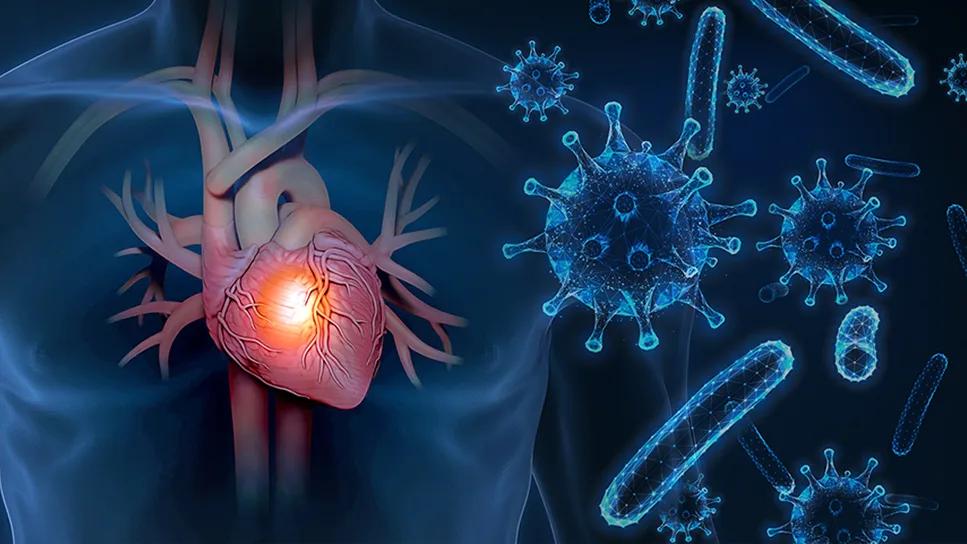Experts encourage customized care, concomitant treatment of substance use disorder and heart infection

This article is reprinted without references from the Cleveland Clinic Journal of Medicine (December 2024, 91(12) 731-734; doi: 10.3949/ccjm.91a.24020). The open-access and fully referenced original article is available at https://www.ccjm.org/content/91/12/731.
Advertisement
Cleveland Clinic is a non-profit academic medical center. Advertising on our site helps support our mission. We do not endorse non-Cleveland Clinic products or services. Policy
People who inject drugs have a 100-fold higher risk of infective endocarditis compared with the general population. The incidence of injection drug use–associated infective endocarditis (IDU-IE) has increased with the opioid epidemic and growing number of people who inject drugs.
The American Heart Association (AHA) recently issued a scientific statement that outlines suggestions and guiding principles for managing IDU-IE. The statement emphasizes the need to treat substance use disorder in conjunction with endocarditis — a stance also endorsed by the American College of Cardiology (ACC) and American Association of Thoracic Surgery (AATS).
We support a multidisciplinary approach that considers how to improve quality of care for IDU-IE from an addiction psychiatry perspective.
Treatment of infective endocarditis should be customized for each patient. The AHA recommends 6 weeks of parenteral (intravenous or intramuscular) antimicrobial therapy. Once acutely stabilized in the hospital, the patient can be discharged to receive outpatient parenteral antimicrobial therapy through a peripherally inserted central catheter for the remainder of treatment.
Alternative methods may be considered in certain situations, such as shortening the duration of parenteral antibiotic treatment, using long-acting lipoglycopeptide therapy, or switching to oral antibiotics.
Improved communication and rapport between staff and patients will help to prevent premature patient-directed discharges. This includes addressing immediate patient needs such as drug withdrawal and pain and providing concurrent comprehensive addiction and psychiatric treatment.
Advertisement
There is no consensus on using outpatient parenteral antimicrobial therapy for IDU-IE, mainly because of limited clinical data. The AHA expressed concerns about the quality of evidence supporting this approach.
Harm reduction is an evidence-based approach that uses interventions aimed at reducing the negative effects of drug-related behaviors without necessarily requiring complete elimination of drug use.
Patient education on the dangers of sharing needles and other drug-use equipment can help reduce injection-related risk behaviors and lower the likelihood of contracting infections. Providing patients with naloxone kits can further improve their health and safety. Some programs offer sterile needles, syringes, and other supplies to patients, which has proven to be an effective method of reducing bloodborne infections like human immunodeficiency virus and hepatitis C.
Harm reduction can also help improve outpatient parenteral antimicrobial therapy access for people who inject drugs. This approach also supports medication-assisted treatment or the use of medication alongside behavioral therapy to treat substance use disorders.
Optimal addiction treatment includes medications for opioid use disorder: buprenorphine, methadone, and extended-release naltrexone. The AHA recommends that medications be offered to every IDU-IE patient with opioid use disorder during hospitalization.
The choice of opioid use disorder medication should be based on the patient’s preferences, addiction treatment history, and availability of medication in the outpatient setting. If patients are already prescribed medication for opioid use disorder, it should not be discontinued during the hospital stay, but it may need to be adjusted.
Advertisement
Medication for opioid use disorder in IDU-IE patients can help manage drug withdrawal symptoms, cravings and pain, and may improve patient engagement and retention.
Stigma, genetic predisposition, trauma, concurrent psychiatric disorders, social support systems, home environment, education, employment and legal circumstances all significantly influence the development and perpetuation of addiction.
Certain strategies help mitigate these factors:
Several models have been used to integrate addiction treatment into the care of patients with IDU-IE. One involves creating an inpatient multidisciplinary endocarditis team that includes an addictionologist. Although the evidence is limited to single-center observational studies, this model has been shown to reduce in-hospital mortality, improve 1-year survival, increase rates of surgery and decrease time to surgery.
Treating IDU-IE is complex and challenging. Addressing the coexisting addiction is essential to achieve the best long-term outcomes. Despite recommendations from the AHA, ACC and AATS, many patients with IDU-IE do not receive substance use disorder treatment in conjunction with heart disease treatment.
Further research, including experimental and observational studies such as randomized controlled trials, cohort studies, and big data analysis, is needed to encourage clinicians to unlearn and change clinical practices. More qualitative studies are also necessary to determine the attitudes, barriers, and facilitators that can guide clinical practice.
Advertisement
Surgeon and cardiology champions are needed to create urgency and empower their addiction colleagues. Large-scale strategies to reduce stigma must be implemented and explored in hospital settings to improve patient-clinician relationships, reduce patient-directed discharges, and improve health-seeking behaviors.
Alternatives such as harm-reduction strategies and supervised consumption sites should also be explored. It is essential to understand the social and structural determinants of people who inject drugs in order to identify new prevention strategies that will decrease the incidence of IDU-IE.
Advertisement
Advertisement

‘Concise clinical guidance’ from ACC distills key advances in imaging and pharmacotherapy

First prognostic tool of its kind for a challenging, debilitating condition

Cleveland Clinic study points to need for new strategies to curb addiction relapse

Insights from guidelines and the Cleveland Clinic experience

Our latest performance data in these areas plus HOCM and pericarditis

Addiction experts use decades of research and clinical experience to help patients overcome substance use disorders

The reassuring potential of psychedelics for the management of substance use and treatment-resistant mental health disorders

Expert urges action to mitigate the tragedy of fatal overdose